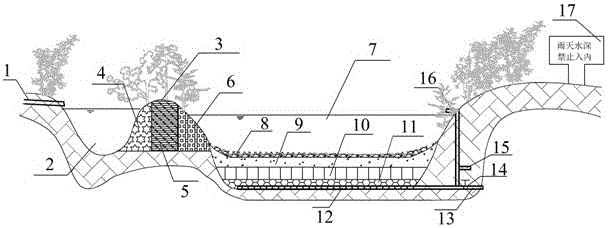Enhanced denitriding and dephosphorizing bioretention pond applied to construction of sponge city
A bioretention pond, nitrogen and phosphorus removal technology, applied in the field of enhanced nitrogen and phosphorus removal bioretention ponds, can solve the problems that the medium loses its water volume regulation and storage function, the aerobic and anaerobic environment is not suitable for control, and the removal rate may not necessarily increase. , to achieve the effects of easy access, improved anaerobic environment, and stable functions
- Summary
- Abstract
- Description
- Claims
- Application Information
AI Technical Summary
Problems solved by technology
Method used
Image
Examples
Embodiment Construction
[0020] An enhanced nitrogen and phosphorus removal bioretention pond applied to the construction of a sponge city is characterized in that: the existing low-lying land is used to build a bioretention pond in the city, and the nearby generated water is collected by pipelines, artificial catchment channels or natural terrain. The surface runoff is collected in the bioretention tank for storage and purification treatment, and the treated rainwater is used for urban greening reuse or replenishing groundwater, or directly discharged to nearby waters; the bioretention tank includes: the pre-precipitation area, the filter area It has three parts and the water purification reaction area, and the three parts are connected in turn.
[0021] Several partitions are built in the front primary sedimentation area, which divides the primary sedimentation area into several small chambers, so that the rainwater flows in an "S" shape inside, increases the hydraulic retention time of rainwater, an...
PUM
 Login to View More
Login to View More Abstract
Description
Claims
Application Information
 Login to View More
Login to View More - R&D
- Intellectual Property
- Life Sciences
- Materials
- Tech Scout
- Unparalleled Data Quality
- Higher Quality Content
- 60% Fewer Hallucinations
Browse by: Latest US Patents, China's latest patents, Technical Efficacy Thesaurus, Application Domain, Technology Topic, Popular Technical Reports.
© 2025 PatSnap. All rights reserved.Legal|Privacy policy|Modern Slavery Act Transparency Statement|Sitemap|About US| Contact US: help@patsnap.com



